

|
|
|
|
|
|
|
WOOD SELECTION |

|

|

|

|

|

|

|

|
| Maple | Ambrosia Maple | Birch | Beech | Cherry | Poplar | Padauk | Purpleheart |

|

|

|

|

|

|

|

|
| Bubinga | Mahogany | Walnut | Butternut | Cocobolo | Sassafras | Red Elm | Oak |

|

|

|

|

|
Pictures courtesy of: FormWood Industries
and HobbitHouse Inc. |
| Ash | Rosewood | Zebra/Zebrano | Cedar | Canarywood |
Lumber Yard LingoInfo courtesy of DrumShed member Sadolcourt:A board foot is a volume of wood 12 inches long x 12 inches wide x 1 inch thick. The formula for finding board feet is L x W x H /144. (You divide by 144 to convert inches to feet.) Example: 120 inches long x 4 inches wide x 1 inch high / 144 = 3.33 board feet. A 4/4 board (spoken as "4 quarter") is nominally 1" thick at the time it's graded. However, it's common practice that the board is planed after grading, and the actual thickness of the board is less than 1", though it is labeled and sold as 4/4 stock. Be aware of this when calculating your usage, and be sure to use the actual thickness provided by your supplier when calculating price. Example: a board measuring 120 inches long x 4 inches wide x .75 inch thick = 2.5 board feet, but the supplier charges for 1" thickness, which is 3.33 board feet. It needs to be mentioned that at Home Depot / Lowes, and some lumber yards, they sell by lineal foot. It is much simpler to calculate costs by multiplying the board's length by the price per foot. The price per lineal foot will be higher for wider boards than for narrower boards. |
Maple Drums |
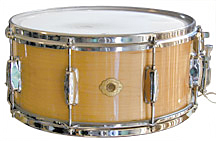
Slingerland Radio King |
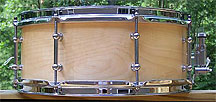
Drum by fienddrummer |
|
(aka Northern Maple, North American Maple, Sugar Maple, Hard Maple) Editor's note: Maple is the most commonly used wood for drum building and is the standard by which most people judge and describe other woods. Crazy8s: Maple is a tad softer sounding (than birch), but warmer and perhaps a bit more accomodating to a less electrified situation. JLee: Maple does have more inherent sustain to it (compared to birch). No doubt about that. shiloh: Hardest, dense, variety of grain pattern, bright, crisp and loud (compared to similar grained woods - cherry, birch, poplar) Close grained. From an online source "Connected Lines": http://www.connectedlines.com/wood/wood30.htm (Note: This site has a long list of wood traits. I've only included the ones that were not "average" or provided some uncommon knowledge). Bending Strength: High Blunting of Tool Blades: Moderate to Severe Density: High Hardness: Hard, difficult to dent (Janka 1450) Kiln-dried Shrinkage: High Movement after drying: Moderate Sawing: High cutting resistance - Wood tends to bind or burn Screwing: Tends to split wood - Requires pre-drilled pilot holes Size of Pores: Small Pores - Closed grain Wood Defects: Honeycomb (or collapse), warp |
Ambrosia Maple Drum |
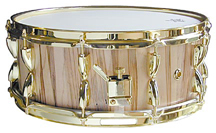
Drum by PDGood |
|
PDGood: When most people think of maple they are thinking of North American maple which is a fairly hard wood. It is around 1450 on the Janka hardness scale. On the other hand, Ambrosia maple is much softer (around 950 if I remember correctly). It is a beautiful wood and easy to work with, but the softness doesn't help the tone any. I built a couple of stave snares out of it and have never been satisfied with the sound. It's not horrible, it just lacks definition and other drums sound better. If you're determined to build one, you might try putting the shell in the Pearl Free Floating system. I've put other soft woods in that system and they have sounded much better than with traditional hoops and lugs. |
Birch Drums |
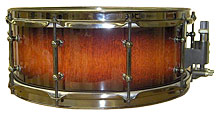
Drum by Unix |

Drum by Altereddesigns |
|
Crazy8s: Birch is brighter and more projecting, and seems to cut through a band a little bit better. ...I prefer birch over all the other woods I've heard used for drums. Using anything else would be for aesthetics... JLee: Birch does have a more focused inherent sound (than maple). No doubt about that... As far as the claims of birch being "naturally e.q'd", etc. - well, I am not so sure about that. Birch drums dont seem to have as much sustain to begin with. It is not by accident that you never see birch drums with re-rings. I think it would cut the sustain even more. As far as the marketing claims that birch drums are preferred in the studio, well, I am not quite buying that one. shiloh: Softer than maple, nice grain subtle colour variances, much warmer than cherry. Close grained. From an online source "Connected Lines": http://www.connectedlines.com/wood/wood30.htm (Note: This site has a long list of wood traits. I've only included the ones that were not "average" or provided some uncommon knowledge). Bending Strength: High Blunting of Tool Blades: Moderate Density: High Gluing: Average - Requires control Hardness: Hard, difficult to dent (Janka gray birch 760, paper birch 910, sweet birch 1470, yellow birch 1260) Kiln-dried Shrinkage: High Movement after drying: Moderate Planing: Average Polishing: Good Sanding: rather difficult Screwing: Tends to split wood - Requires pre-drilled pilot holes Size of Pores: Small Pores - Closed grain Wood Defects: Check (or split), honeycomb (or collapse), stain |
Beech Drum |

Drum by Unix |
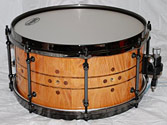
Drum by Sonorguy |
|
Drumgodguy: Yes Maple is great and Birch is penetrating , but beech is the best of both... sonorguy: It is similar to oak to work with, The grain is closed a bit more. Coco: The beech I was using has shrunk beyond repair... I am going to keep away from beech for now. It moves too much for this time of year really, going freezing cold at night and hot in the day time whilst I am at work makes it so vulnerable to move. shiloh: If the beech over there is anything like what's over here, it's a "beech" to stabilize, the stuff seems to move at the slightest breeze!! I've seen whole boards go cork screw almost over night. |
Cherry/
|
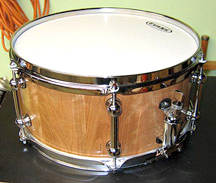
Drum by Sadolcourt |
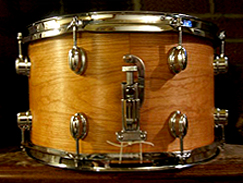
Drum by Wittpercussion |
|
shiloh: Hard, dense, variety of grain pattern and colour, bright and warmer than maple. Close grained. tmaple: Cherry by nature will darken rather quickly. It darkens by light especially sun light. Give it the old sun tan (Literally set it in the sun for a day. Be sure to give some rotation) and see if it starts to darken. Woody: UV rays will affect the color of certain woods, notably cherry and purpleheart. Look for an oil based topcoat with a UV protectant in it. Kanbasher: I like the sound of a cherry shell (a lot) but keep in mind that cherry is brighter than maple to start with and a stave shell will produce a higher frequency than a ply shelled shell. This may not be the wood you would want to use for the sound you are describing (fat sounding) but would make for a beautiful snare regardless (sound & looks). sadolcourt: Use a slow router speed on Cherry. Fast speed will burn the wood. Baumstrunk: Please be aware, Brazilian Cherry is NOT a Cherry. It is one of the so-called pseudo-woodspecies. The proper name for this is JATOBA or courbaril. This does not mean that the wood is of lower value than real cherry! The name is just confusing imo. Phat Tubz: I have used Jatoba (Brazillian Cherry) before. It makes a wonderful sounding snare drum. Very Loud! It's kind of hard to work with being that you have to use twice as much sand paper as when working with maple. Jatoba also gets hot very quickly and you have to be careful not to burn the joints. Jatoba goes for about $5 a board foot here in San Diego, CA. That makes it about $3 a board foot cheaper than Walnut, or Cherry. It takes between 4 1/2 - 6 board feet to make a snare drum depending on what size you want. From an online source "Connected Lines": http://www.connectedlines.com/wood/wood30.htm (Note: This site has a long list of wood traits. I've only included the ones that were not "average" or provided some uncommon knowledge). Bending Strength: High Blunting of Tool Blades: Moderate Density: Moderate Gluing: Average - Requires control Grain: Straight Hand Tooling: Average Hardness: Average (Janka: 950) Harmful Properties: Non Toxic Kiln-dried Shrinkage: Low Machine Tools: Average Movement after drying: Moderate Planing: Good Polishing: Good Sanding: Insufficient Data Available Sawing: Low cutting resistance Screwing: Good - Screwing seldom splits wood Size of Pores: Small Pores - Closed grain Wood Defects: Ring check, warp |
Poplar Drum |
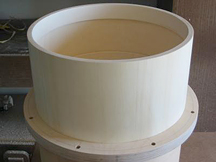
Shell by Mic |
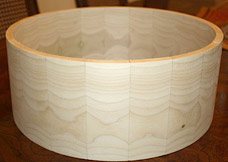
Shell by trieck |
|
shiloh: Softest of the hardwoods, plain almost maple like grain, whitesh to green in colour, alright in tone warmish and crisp, leaning towards dry mundane (all easily finished). Close grained. PDGood: Often used as a filler between plies of wood that are thought to be better sounding or stronger. Very little info available on the sound of Poplar by itself. michael_watkins: The maples, birch and surprisingly, the poplar, all have similar characteristics. Poplar is softer so it is really in the middle regarding tonal range and hardness, but contrary to popular belief, it actually sounds quite good. |
Padauk Drums |
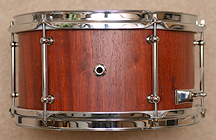
Drum by one_beat |

Drum by smeyer |
|
Crazy8s: ...brighter and projects more (than maple and birch). smeyer: Padouk can vary a lot from piece to piece. Sound wise the I know that the Bubinga and Padouk are pretty similar, lots of high end, lots of attack especially in a stave shell. Bubinga usually has a little more high end and more sustain. Padouk is slightly more mellow. JLee: Paduak is supposed to be really hard wood, if i am not mistaken. one_beat: Yeh, it is a very hard wood. Much harder than oak, just one stave for this drum sounded so different to a stave from one of the oak drums did. I think the densities are similar, but the padauk is very hard. sadolcourt: Use a slow router speed on Padauk. It tends to splinter at high rpms. From an online source "Connected Lines": http://www.connectedlines.com/wood/wood30.htm (Note: This site has a long list of wood traits. I've only included the ones that were not "average" or provided some uncommon knowledge). Bending Strength: High Blunting of Tool Blades: Low Density: High Gluing: Good Grain: Mostly Straight Hand Tooling: Average Hardness: Hard, difficult to dent (Janka: African Padauk 1725) Harmful Properties: May cause dermatological and respiratory problems Kiln-dried Shrinkage: Low Machine Tools: Easy to Very Easy Movement after drying: Low Planing: Average Polishing: Good Sanding: Good Sawing: Moderate cutting resistance Screwing: Fair - May require pre-drilled pilot holes especially near ends Size of Pores: Large Pores - Open grain Wood Defects: Few drying defects |
Purpleheart Drums |
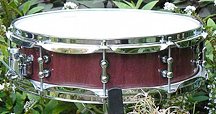
Drum by Koko |
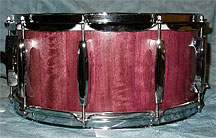
Drum by Jo Mig |
|
Crazy8s: ...brighter and projects more (than maple and birch). smeyer: Freshly sanded purpleheart is often much lighter (in color) and more bland (than when it is finished). OPFOR: I love purpleheart...despite the fact that it chews up router bits. smeyer: It tears out terribly. Pain in the butt. From an online source "Connected Lines": http://www.connectedlines.com/wood/wood30.htm (Note: This site has a long list of wood traits. I've only included the ones that were not "average" or provided some uncommon knowledge). Bending Strength: High Blunting of Tool Blades: Moderate to Severe Density: Very high Hand Tooling: Average Hardness: Very Hard, extremely difficult to dent (Janka 1860) Kiln-dried Shrinkage: Low Machine Tools: Average Movement after drying: Low Planing: Fair Polishing: Good Sanding: Good Sawing: Moderate cutting resistance Screwing: Fair - May require pre-drilled pilot holes especially near ends Wood Defects: Check (or split), case harden, stain, warp |
Bubinga Drums |
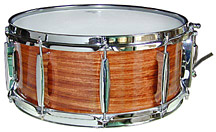
Drum by PDGood |
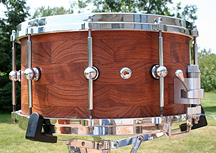
Drum by danthespaceman |
|
smeyer: Sound wise the I know that the Bubinga and Padouk are pretty similar, lots of high end, lots of attack especially in a stave shell. Bubinga usually has a little more high end and more sustain. koko: Beautiful grain pattern, deep warm looks, sounds are always nice. From an online source "Connected Lines": http://www.connectedlines.com/wood/wood30.htm (Note: This site has a long list of wood traits. I've only included the ones that were not "average" or provided some uncommon knowledge). Bending Strength: High Blunting of Tool Blades: Moderate to Severe Density: Very high Gluing: Average - Requires control Grain: Mostly Straight Hand Tooling: Average Hardness: Hard, difficult to dent (Janka: 2690) Harmful Properties: Non Toxic Kiln-dried Shrinkage: Moderate Machine Tools: Average Movement after drying: Low Planing: Fair Polishing: Very Good Sanding: Good Sawing: Low cutting resistance Screwing: Tends to split wood - Requires pre-drilled pilot holes Size of Pores: Small Pores - Closed grain Wood Defects: Check (or split,) warp |
Mahogany Drums |
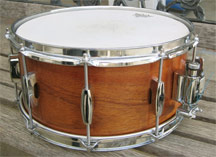
Drum by Skaman |
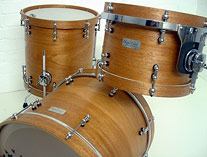
Drums by GHeeley |
|
Mahogany (unspecified type) smoke_n_drums: Mahogany has a darker deeper tone (compared to maple). J.Richard: I've always liked Mahogany. I prefer a warmer sound since I use calf heads a lot. I do have drums made from birch/maple and I do enjoy their sound and feel as well, for different styles of music. ctdrum1: If you want something warmer and rounder in tone go with mahogany. Mahogany (African) From an online source "Connected Lines": http://www.connectedlines.com/wood/wood30.htm (Note: This site has a long list of wood traits. I've only included the ones that were not "average" or provided some uncommon knowledge). Bending Strength: Moderate Blunting of Tool Blades: Low Density: High Gluing: Average - Requires control Grain: Mostly Straight Hand Tooling: Average Hardness: Average (Janka: 830) Harmful Properties: Non Toxic Kiln-dried Shrinkage: High Machine Tools: Average Movement after drying: Low Planing: Fair Polishing: Good Sanding: Fair or satisfactory Sawing: Low cutting resistance Screwing: Good - Screwing seldom splits wood Size of Pores: Large Pores - Open grain Wood Defects: Few drying defects Mahogany (honduran) shiloh: One of the only imports I use, an eco friendly species (plantation trees), a little softer than walnut, nice grain patterns, reddish, salmon, yellowy browns, gold, pleasant colours, similar in sound qualities as walnut or butternut, somewhere in between. Easy to finish. |
Walnut Drum |
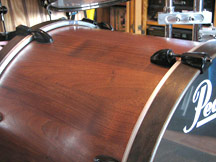
Drum by neotim |
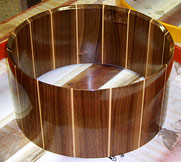
Drum by Unix |
|
Jeff Hankin of Carolina Drumworks: Well, just as rosewood is harder than maple, walnut is softer than maple, so it's a little rounder tone without quite as much edge on it. Walnut is a great wood for a blues-rock sound, with strong mid-tones and warmth. shiloh: Black walnut is the hardest (of similar wood types butternut, Honduran mahogany) dense, nearly as hard as maple, varying grain patterns, light brown to deep chocolate, very dusty, pleasant aroma, warm sharp crisp sound quality. steve_c1234: Qld walnut looks great, sounds not so good, and is a really nice wood to work with. This stuff is queensland walnut, different to american walnut. It just doesn't have much life to it. It makes nice guitars though Maton use It on some of their acoustics. pdgood: My experience is limited to one walnut drum - a 7" x 14" ply snare. It is the brightest drum I own - brighter than birch, ambrosia maple, zebrawood and even brass. I can't really say about the fullness because the shell is so deep that's a bigger factor than the wood. I don't hear any particular warmth on mine although I've heard others say that walnut is warm. Playing response is terrific even at this depth. It plays like a 5" deep shell. It's completely different from what I expected. I thought walnut would be warm, dark, and not too bright. This drum is just the opposite. |
Butternut Drum |
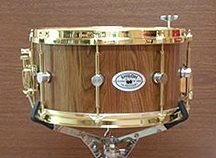
Drum by Shiloh |
|
shiloh: Softest of the three (black walnut, butternut, honduran mahogany), this wood produces a very pleasing big wet fat sound, the deeper the shell the fatter. Similar to walnut, but lighter in weight and colour (musty brown to golden in appearance) and half as dense, easy to work, to me, sort of nuetral aroma, will tear out easy if tools are not real sharp, very dusty. In shell thicknesses of 5/8 to 3/8" it produces a very warm fat sound,I build mainly 14-13"ers with this wood. Is fairly fragile in thin shell form these I re-ring for added support. This wood finishes beautifully, both natural and stained, when burly is similar to walnut with the opalescent effect. |
Cocobolo Drum |
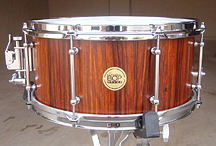
Drum by HardBopDrums |
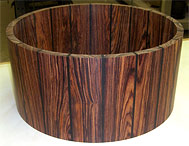
Drum by Unix |
|
hardbopdrums: I just finished building my first Cocobolo stave shell snare. My best selling snares in the past had been my Cocobolo Segment shell snares, but I no longer can get them. I have 2 sources for Segment shells and one of the builders in now very allergic to the Cocobolo dust and my other guy is not using Cocoboloas it is becoming endangered. It is not endangered, but it is becoming more rare and he does not want to add to this process. I took an order for a 14x7 Cocobolo segment snare and was told by my one builder that he would do it, but he dropped the ball. I now had a customer and I need to get a shell. The guys who do the segment shells can use smaller pieces of wood, so the cost of the Cocobolo segment shells were still fairly reasonable. They were about 50% more expensive than say a Bubinga shell, but they were still reasonable. With Stave shells, they need to buy larger boards, so the cost of the Cocobolo stave shells is REALLY expensive. I had to pay $150.00 more to get the Cocobolo Stave shell vs the Segment, but I had to fulfill the order for my customer. To give you an example, the most expensive woods that I normally deal with are Bubinga, Zebrawood and Padauk, but this Cocobolo shell was more than double the cost of those shells. I received this shell last week and finished it Thursday. I took it to a lesson I was teaching on Friday. This drum is not only the prettiest drum I have ever seen or built, but it is also the best sounding drum I have ever played or built. I was ABing it next to the 14x7 Rosita Wood segment shell snare that I have been using for about 6 months. They were both similar in fullness of tone and sensitivity throughout the dynamic range, but the rim shots on the Cocobolo were just amazing. This drum also had that "feel" that I think people here know when they play an unvented snare with triple flanged hoops and a CRANKED snare side head. In the past I had mainly obtained that "feel" with deep 13" snares. This 14x7 had that IDENTICAL feel and it almost felt like it played itself. I forgot to mention that this Cocobolo stave shell is one of the 5/16" shells with the integrated reinforcement hoops. I am still 50/50 on the stave vs segment shells for snares, but this drum really moved me. These will be the most expensive snares I have ever built, but when you compare them to what many of these companies are charging for a snare drum today, it still is a bargain! smeyer: Cocobolo can vary a lot from piece to piece. Some people like to use select pieces of cocobolo because it looks a lot like Brazilian Rosewood, and is a Rosewood species. Cocobolo can sound like Brazilian Rosewood depending on the piece. Comments from customers are that the shells in this range of hardness are very responsive, like a metal shell, but with a lot more range. From an article by bnet business network - http://findarticles.com/p/articles/mi_m3156/is_11_104/ai_n25026571: Cocobolo is more than just another pretty face. The wood is heavy, strong, durable and resistant to preservative treatments. Cocobolo contains natural oils that allow the wood to be polished to a finish resembling marble. Veneers, A Fritz Kohl Handbook describes cocobolo as "an absolutely superior wood. Due to its high oil content the surface appears dense with waxy luster." Constantine Jr., writes that "if the smooth surface is rubbed with a cloth it will acquire a waxy finish without the use of any oil, wax, shellac or filler. Lengthy immersions in soapy water have little effect on the wood except for a slight darkening in color." Although cocobolo is a fine turning wood and most consider it easy to work with, sanding and machining the wood produces a fine dust that can cause dermatitis or a poison ivy-like rash. The dust can also cause orange stains when it comes into contact with skin. Boston-area custom woodworker Eric Englander agrees that the wood's dust can be problematic. "People I know who use it wear a mask, gloves and long sleeves when they are working with it," he says. Albert Constantine Jr., in Know Your Woods, expresses similar concerns about cocobolo's dust. "When working with cocobolo," he writes, "care must be taken to protect oneself from the fine dust, as it produces a poisoning similar to ivy poisoning. It can become very painful. When affected, a person usually has to remain away from work for a week and then may never again be able to be in a room where there is any cocobolo dust." |
Sassafras Drums |
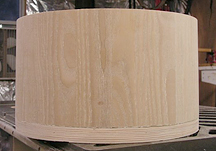
Drum by Shiloh |

Drum by Shiloh |
|
shiloh: Similar grain pattern to oaks, ashes, though much ligher in weight, the natural colour is a carmel, yellow brown, smells like cold medicine when cut, I like it, it`s pleasant. One needs to have lots on hand, tends to be very knotty, more waiste than most. This wood produces a warm, fat punchy sound in 14-13"ers, similar to ash but softer, has a great tuning range, both butternut and sass. need to be really cranked to get it ringy (heads edges also effect this as well). I`ll also use this to make complete kits, big sound in small sizes. This wood is easy to work with, though tooling needs to be sharp as the grain tends to undulate, hard to soft between the grain, like ash or oak, there are hard and soft spots in the grain, I leave extra OD for sanding out, to allow for evening the grain. (Wear a mask as this stuff is very dusty) Finishes well naturally or stained. Sassafras, often mixed in with ash when cut, is the softest (of similar grained woods like Red Elm, Oak, and Ash), open grained, light in weight, produces a very warm wet sound with lots of presence. soft carmel in colour, very aromatic. Difficult to finish due to the open grain. |
Red Elm Drum |
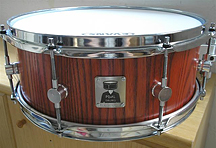
Drum by Shiloh |
|
shiloh: Hardest (compared to other open grained woods like Oak, Ash and Sassafras). Dense open/tight grained reddish brown color outstanding grain pattern, bright and warm, very fat on deeper shells, splintery and stinky! Difficult to finish due to the open grain. |
Oak Drums |
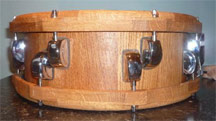
Drum by deno |
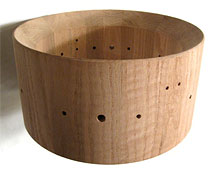
Red oak drum by Young'un/Joshua Tree Percussion Co. |
|
shiloh: As hard as red elm, more open grained, same qualities as red elm, local varieties include white and red, white being more blonde, tone greatly enhanced with depth of shell, warmer fatter. Difficult to finish due to the open grain. michael_watkins: The oaks tend to splinter too, and are a little more difficult to work, but they produce the best live sound of any woods I have used. They are loud and crack nicely when struck. They also have good tonal range. I rarely stain my drums, but oak takes stain very well, with no conditioner required at all. |
Ash
|
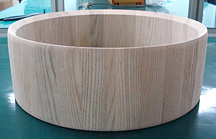
Drum by cola1218 |
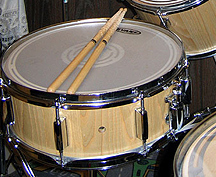
Drum by Sadolcourt |
|
shiloh: Similar to oak but not as dense, nice varying open grain patterns, range in colour includes blondes to yellowesh browns/black, varieties locally white yellow black, bright, warm, crisp sounds. Difficult to finish due to the open grain. |
Rosewood Drums / Morado |
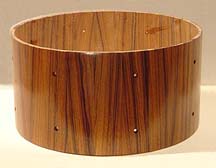
Drum by smeyer |
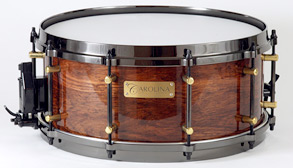
Drum by Carolina Drumworks |
|
smeyer: New shell from our shop (is) Morado. Bolivian Rosewood. Very similar properties to Brazilian, mostly orange to red in color, not quite as insane as real Brazilian but very similar working characteristics. I think this is an excellent option maybe second to some really nice cocobola. Similar in density to bubinga and padouk. RacerX: I've got a Segment made from Bol Rose. Sounds just super. |
Zebrawood Drums
|
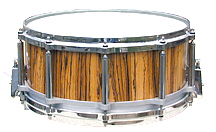
Drum by Koko |
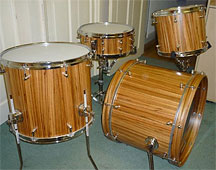
Drum by deano |
|
Some background information on zebrawood from an online source that sells zebra wood humidors: http://www.cigarmony.com/index.asp?PageAction=VIEWPROD&ProdID=173 Zebra Wood - is found primarily in the African rain forest of Cameroon. The trees are large in size and are located in remote areas making it difficult and costly to harvest. Its striking grain of alternating black and brown stripes on a tan background is reminiscent of a zebra hence its name Zebra wood. It is 25% harder than Red Oak and has a lustrous surface that finishes well. Over time Zebra wood undergoes a medium degree of color change with the ambering and darkening of the tan background into a more golden brown and the dark striping becomes darker. PDGood: I have a beautiful stave Zebrano snare made by Koko which I put in a Free Floater. It's three most distinctive traits are: (1) It is very sensitive - you can hear every little grace note, (2) It is loud - in fact it is the loudest snare I have, (3) It has a higher pitch than expected for the size of shell. This is especially good for funk and anything fast. It's not a ballad snare. From an online source "Connected Lines": http://www.connectedlines.com/wood/wood80.htm Blunting of Tool Blades: Moderate Density: Very high Hardness: Average (Janka 1575) Harmful Properties: Non Toxic Kiln-dried Shrinkage: Moderate Movement after drying: Low Screwing: Good - Screwing seldom splits wood Size of Pores: Large Pores - Open grain Wood Defects: Check (or split,) warp |
Cedar Drum |
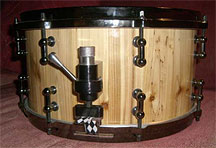
Drum by michael_watkins |

Drum by sadolcourt |
|
michael_watkins: My experience with cedar is that it's a very soft wood and therefore easy to work with. The snare I made was 13" and it has a deep, warm fundamental pitch. It's not extremely loud and the tuning range is moderate. I used it in the studio and it produced a fat, deep rock sound using an Evans Genera Dry head and cast hoops. For my taste, single ply heads required a moon gel to eliminate ring. Regarding workability, the soft cedar wood will splinter, so use a sharp bit and work slower than you would with harder woods. These boards were also thinner than standard 3/4" stock, so I only shaved off around 1/16" outside diameter. The shell ended up just under 1/2" thick using 20 staves. In retrospect, I should have used 24 staves to get closer to 1/2" (and better match the 8 lug configuration). Cedar also has a lot of knots that you have to cut around, so waste is higher than hardwoods. The drum shell is also very lightweight - I was surprised how much so. Finish was a breeze; tung oil to bring out the color and characteristics, finished with briwax and lightly buffed. While not aromatic cedar, the smell is still very pleasant - light, but typical cedar. The woods I have used in stave construction include ambrosia maple, hard maple, kerlian birch, walnut, poplar, red oak, white oak, northern pine, zebra and cedar. Of these, cedar was the easiest to work with, followed by the northern pine. all of the others are about the same. sadolcourt: I made this (cedar) shell a bit ago, and handed it to a dude who knows a thing or three about drums. So I asked him if it sounded good. He told me this was a dull sounding shell, no life, kinda like a cardboard box. So...while red cedar looks cool, smells great, and machines like butter, it's sonically a no-go. hippybaker: Cedar is pretty soft. It probably wouldn't take a lifetime of abuse on the road, and the lugs may waller out the holes a bit. sasolcourt: I'd agree. To remedy that, I'd enlarge the lug holes and epoxy in some thin wall steel tubing. That would reinforce the lug hole pretty well. |
Canarywood Drum |
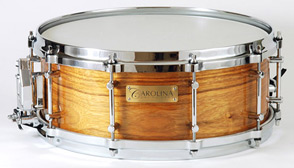
Drum by Carolina Drumworks |
|
Jeff Hankin of Carolina Drumworks: Canarywood is a nice, light weight hardwood with excellent tone. You see it used in guitars and speaker enclosures for its sound qualities. It's very easy to work with; tools go through it like cutting butter. The grain can be a little more open than it would first appear, but it's not as difficult to fill as some others. Canarywood can get to be more of a bright yellow as it ages. |